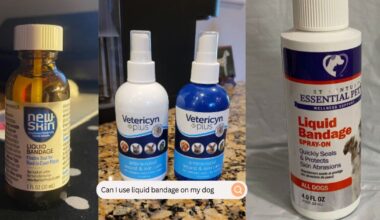About the Author: Introducing Dr. Adriana Luis, our Senior Content Editor at MyPetDoggie and also Veterinarian (MVZ). Kerry devotes most of her time to penning enlightening pieces about pet health, providing invaluable knowledge to pet owners globally. As the director of our Veterinary Content Team, she ensures the accuracy and comprehensiveness of our content, thereby making pet care accessible and understandable for everyone.
Can dogs have freckles? Our beloved furry friends come in all shapes and sizes and many have markings that are unique to them, so it’s not a surprise that some of us have asked if they can have freckles, too!
In this blog, we’ll take a closer look at this question and explore if dogs can have freckles on their skin and nose. So, stay tuned for more!
You can also read: Helpful Guide – What to Know Before Adopting a Dog
What are Freckles?
Freckles are small, dark spots that are usually on the skin of the face, hands, and feet. They are caused by a pigment called melanin.
Melanin is produced by the cells in the skin and is responsible for the color of the skin. Freckles are common in people of all races and can be light or dark in color.
You can also read: Insightful Information – Are Shock Collars Safe for Humans?
Can Dogs Have Freckles on Their Skin and Nose?
Yes, dogs can have freckles on their skin and nose. Freckles in dogs are usually caused by the same pigment that causes freckles in humans.
The freckles can be light or dark in color and can be found on the face, ears, and nose. The freckles can also be found on the chest, legs, and paws.
However, it is important to note that freckles in dogs are not as common as they are in humans.
You can also read: Celebrity Pet Insights – What Type of Dog Does Lexi Hensler Have?
Causes of Freckles in Dogs (or Lack Thereof)
There are several possible causes of freckles in dogs. The most common cause is a genetic predisposition, meaning the dog inherited the trait from its parents. Other causes could be a hormonal imbalance, sun exposure, or a medical condition such as vitiligo.
Additionally, some breeds are more prone to have freckles than others, such as Dalmatians, Bull Terriers, and Boston Terriers.
You can also read: Fascinating Fact – How Big of a Dog Can an Owl Pick Up?
What dog breeds have freckles?
As we mentioned, some dog breeds are more prone to freckles—Dalmatians, Bull Terriers, and Boston Terriers, among many others.
These breeds are more likely to have freckles on their skin than other breeds, and they may also be more prone to sunburns. Some people believe that freckles are a sign of a dog’s health and vitality and that they are a sign that the dog is in good physical condition.
You can also read: Insightful Information – When is a Boxer Full Grown?
Sun Exposure as a Factor
Sun exposure is an important factor in developing freckles on a dog’s skin. Dogs exposed to a lot of sunlight are more likely to develop freckles than those kept indoors.
If you have a dog that spends a lot of time outside, it is vital to ensure that they are wearing sunscreen or other protective clothing to help prevent the development of freckles, especially if they have susceptible skin.
Freckles are usually harmless but can develop bad traits if left unattended.
You can also read: Important Considerations – When is a Pitbull No Longer a Puppy?
How can I check if my dog has freckles?
The following signs may indicate that your dog has freckles:
- Dark spots on the skin.
- Red or brown patches.
- Spots that may be slightly raised.
- Spots that may be darker in color than the surrounding skin.
If you notice any of these signs on your dog, it is important to take them to a vet as soon as possible.
The vet will be able to examine your dog and determine if they have freckles and if they need any treatment.
You can also read: Expert Tips – When Can Puppies Go in the Backyard?
Diagnosis and Treatment of Dog Freckles
Brown spots on your dog’s skin can be a sign of a serious underlying medical condition, and should not be ignored. It is important to seek veterinary advice if you notice any unusual changes in your dog’s skin. Early detection and treatment of any skin condition can help prevent more serious health problems in the future.
Some types of them develop into melanomas, which are cancerous growths. It is important to have your dog examined by a veterinarian to determine if the freckles are benign or malignant.
If the freckles are benign, no treatment is necessary. If the freckles are malignant, treatment will be necessary to remove them and to prevent future growth.
Treatment may include surgical removal, chemotherapy, or radiation therapy.
You can also read: Curious Behavior – Do Dogs Yawn When Happy?
FAQs: All About Dog Freckles
Are dog freckles normal?
Freckles, often referred to as Ticking, are commonly seen in certain dog breeds and tend to become more visible with age or when exposed to the summer sun. This is due to a set of dominant genes that affect the production of melanin in the eyes, fur, and skin of your pup.
Can dogs have black freckles?
Yes! Regarding our canine friends, spots caused by melanin may appear on their skin and tongue. If a pup has black speckles on its tongue, this could be attributed to additional pigmentation. Breeds with darker noses or lips may also have darker patches of pigmentation on their gums as well as on their tongue.
Can dogs have freckles on their ears?
Yes, they can, especially if they have less hair and very sensitive skin.
What is an iris freckle on a dog?
An increase in pigmentation of the iris causes eye freckles. They may be present from birth or may appear gradually and may also be associated with UV exposure. Generally, only one eye is affected, though both may be in some cases. It’s observed in some dog breeds that have blue eyes, such as the Siberian Husk are prone to have iris freckles.
You might be interested in: Learn essential tips on keeping your dogs safe during wildfires and evacuation planning.
Conclusion: Are Dog Freckles Harmful?
In most cases, freckles are benignant and suppose no harm to your dog. However, if you notice any particularly big one, or you notice they are starting to gain volume, take your pet to the veterinarian for a quick check. Remember the faster you act the better the outcome in case of a problem.






